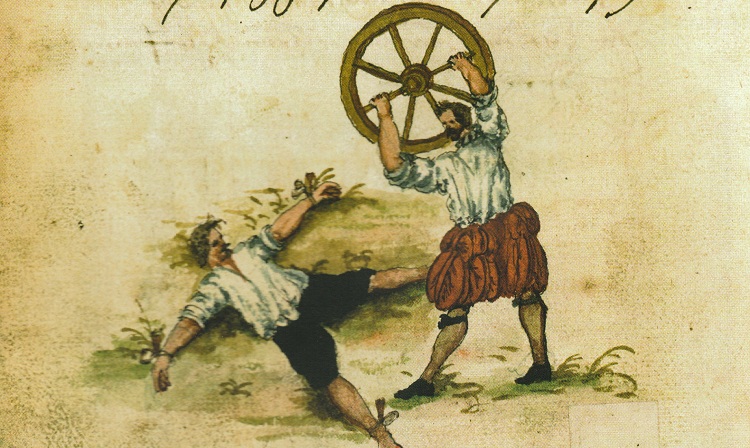
Okay, without looking, what do you picture when you see the phrase “broken on the wheel,” as in the old-timey medieval execution method?
(WITHOUT LOOKING.)
LIKE SELF, you probably had a general sense of some bejerkined fellow stretched out over a big wheel (possibly the kind of wheel that spins on a water-mill, possibly a big ol’ wagon wheel; either one) and then sort of…somehow…stretched to death? LIKE SELF, your sense of history is unhelpfully vague. But the concept definitely involves being strapped to a wheel, and contorted into all sorts of unhelpful positions; it’s a bizarre and an alien image, right?
WRONG. THAT IS NOT HOW A PERSON IS BROKEN ON THE WHEEL. HERE IS HOW A PERSON IS BROKEN ON THE WHEEL, AND IT IS THE MOST DISAPPOINTING THING I HAVE EVER LEARNED:
This is from The Faithful Executioner, which is easily the greatest book in the world, but I have never been more disappointed than when I saw this sketch of Meister Frantz executing his own brother-in-law “on the wheel” – by simply picking up a big wagon wheel and slamming it into him.
That’s it. That’s the eerie, vaunted, made-much-of medieval torture device. That’s THE WHEEL. They tie you to the ground and some beefy, thatch-headed, doubletted executioner flings a wheel at you until you are dead. It’s just being beaten. They could just as easily fling a large rock at you, or a sturdy antimacassar, were one readily available.
“Fling the wheel on him, lads,” the figures seem to say. “Never mind the misleading turn of phrase ‘breaking on the wheel. Merely fling a wheel at his joints until he dies, PROSAICALLY AND DISAPPOINTINGLY.”
Wikipedia’s even worse:
“Alternatively, the condemned were spreadeagled and broken on a saltire, a cross consisting of two wooden beams nailed in an “X” shape, after which the victim’s mangled body might be displayed on the wheel.”
THAT DOESN’T EVEN INVOLVE A WHEEL UNTIL THE END, THAT’S JUST BEING BURIED ON A WHEEL
“During the execution for parricide of Franz Seuboldt in Nuremberg on 22 September 1589, a wheel was used as a cudgel. The executioner used wooden blocks to raise Seuboldt’s limbs, then broke them by slamming a wagon wheel down onto the limb.”
WHY NOT JUST USE A CUDGEL THEN
“In France, the condemned were placed on a cartwheel with their limbs stretched out along the spokes over two sturdy wooden beams. The wheel was made to revolve slowly, and a large hammer or an iron bar was then applied to the limb over the gap between the beams, breaking the bones. This process was repeated several times per limb. Sometimes it was “mercifully” ordered that the executioner should strike the condemned on the chest and abdomen, blows known as coups de grâce (French: “blows of mercy”), which caused fatal injuries.”
I don’t know. That helps a little, I guess. But knowing that just as often as not, being broken on the wheel just meant getting beaten with one?
Nothing’s any good.
Mallory is an Editor of The Toast.


